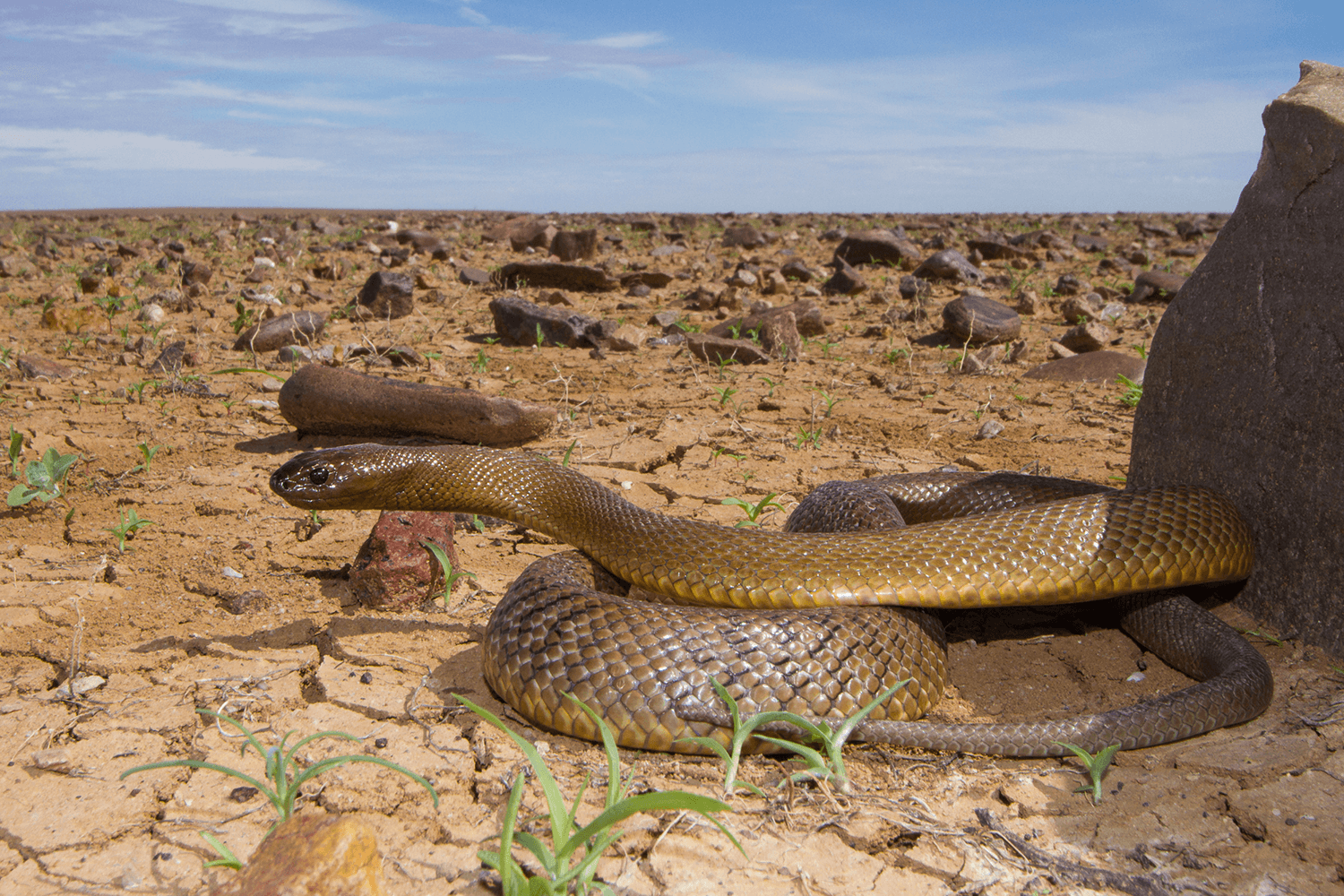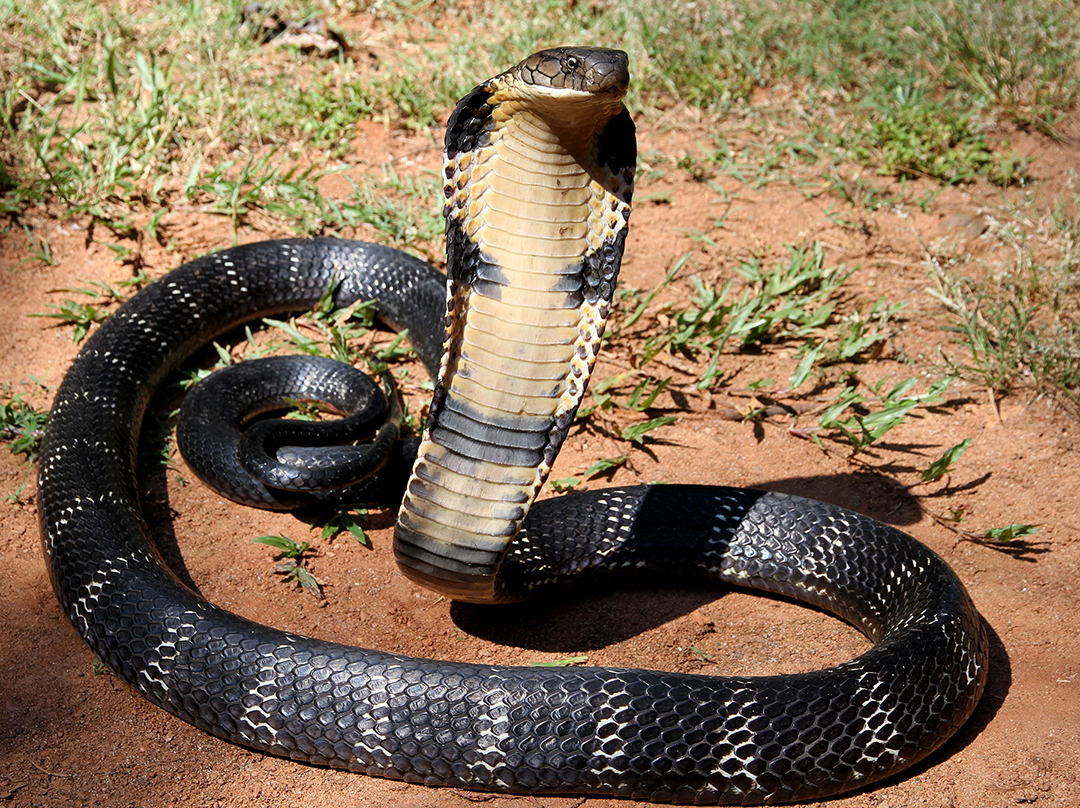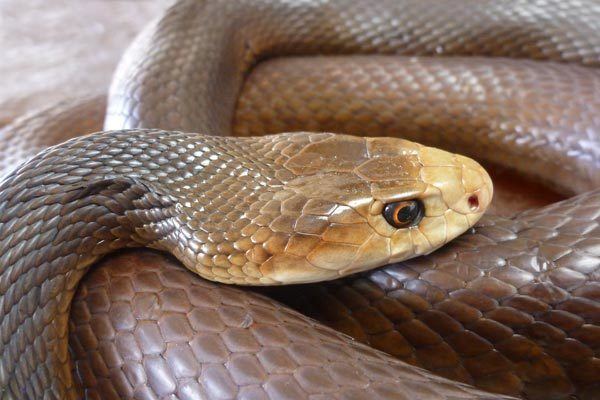
Poisonous snakes of the world
Poisonous snakes of the world
1. inland taipan

- The bite of an inland or western taipan—Oxyuranus microlepidotus, also called, appropriately, the fierce snake—delivers a veritable witch’s brew of toxins.
- Generally regarded as the world’s most venomous snake, the inland taipan is appropriately known as ‘the fierce snake’.
- Living in more remote locations than the coastal taipan, the inland taipan rarely comes into contact with humans, the Australian Museum reported.
- These dark-marked scales occur in diagonal rows so that the marks align to form broken chevrons of variable length that are inclined backward and downward. The lowermost lateral scales often have an anterior yellow edge.
2. King cobra

- The king cobra (Ophiophagus hannah) is the longest venomous snake in the world. Its bite delivers a tremendous amount of paralysis-inducing neurotoxins.
- With a 50% fatality rate for untreated human bites, the king cobra is an apex predator that deserves to be high on this list of venomous snakes.
- Even a single bite can kill a human in 15 minutes and an adult elephant in just a few hours, Sean Carroll, molecular biologist at the University of Maryland, wrote in The New York Times.
3. black mamba

- Africa's deadliest snake, the black mamba (Dendroaspis polylepis) can kill a person with just two drops of venom, Live Science reported. Named for the dark, inky color inside of their mouths, black mambas are actually brownish in color.
- As with all snakes, mamba generally try to avoid confrontation with humans, but if backed into a corner they are more than happy to stand their ground and fight.
- The venom of the black mamba is a protein of low molecular weight and as a result is able to spread rapidly within the bitten tissue.
- Despite its aggressive reputation, unprovoked attacks on humans have not been proved, and it is responsible for only a small number of deaths annually.
4. Coastal Taipan

- The coastal taipan is found in coastal regions of Northern and Eastern Australia and the nearby island of New Guinea.
- Adult specimens of this species typically attain sexual maturity around 1.2 m (3.9 ft) in total length (including tail)
- Before 1956, when an effective antivenom was produced, this snake's bite was nearly always fatal, according to Australian Geographic.
- The coastal taipan (Oxyuranus scutellatus) produces venom that is nearly identical to that of its inland cousin. Its bite is lethal in more than 80 percent of untreated cases.
5. Banded krait

- The banded krait (Bungarus fasciatus) is a highly venomous relative of the cobra. Its venom is essentially a neurotoxin that induces paralysis
- The snake's venom can paralyze muscles and prevent the diaphragm from moving, according to a 2016 study published in the journal PLOS Neglected Tropical Diseases.
- It’s a shy, nocturnal snake that doesn’t go out of its way to bite people, though when bites do happen their venom can cause respiratory failure and potentially suffocation.
6.Eastern Brown Snake

- Native to Eastern and Central Australia and Southern New Guinea, the solitary and fast-moving eastern brown snake is found in most habitats apart from dense forests.
- The colour of its surface ranges from pale brown to black, while its underside is pale cream-yellow, often with orange or grey splotches.
- It’s considered the world’s second-most venomous land snake and is responsible for about 60% of snakebite deaths in Australia.
- The eastern brown snake is of slender to average build with no demarcation between its head and neck
7. eastern tiger snake

- The eastern tiger snake (Notechis scutatus) is the most widely distributed type of tiger snake, which inhabits the southern fringe of Australia and the region’s nearby islands.
- Its potent venom can cause poisoning in humans in just 15 minutes after a bite and is responsible for at least one death a year on average, the University of Adelaide reported.
- Fatal to hums if left untreated, tiger snake bites account for an estimated 17% of Australian snakebite victims.
- When threatened, they flatten their bodies and raise their heads above the ground in a classic prestrike stance.
8. Boomslang

- About 24 hours after being bitten on the thumb by a juvenile boomslang (also called a South African green tree snake), herpetologist Karl Patterson Schmidt died from internal bleeding from his eyes, lungs, kidneys, heart and brain, researchers reported in 2017 in the journal Biochimica et Biophysica Acta.
- A rear-fanged snake, it delivers its venom by chewing on its victim until the victim succumbs to the toxins.
- In this species, the head is distinct from the neck and the canthus rostralis is distinct.
- The tail is long, and the subcaudal scales are paired. Ventral scales are 164–201; the anal plate is divided; and the subcaudals are 91–131.
9. Saw Scaled Viper

- The saw-scaled viper is found in parts of India and the Middle East and is the snake responsible for the most human deaths each year.
- There are 10-12 supralabials, the fourth usually largest, and 10-13 sublabials.
- The color-pattern consists of a pale buff, grayish, reddish, olive or pale brown ground color, overlaid middorsally with a series of variably colored, but mostly whitish spots, edged with dark brown, and separated by lighter interblotch patches.
- Hydration and antivenom (there are nine types of antivenom for this snake) should be administered within hours of the bite for a person to survive, Understanding Animal Research said.
10. Fer-de-lance

- A bite from a fer-de-lance (Bothrops asper) can turn a person's body tissue black as it begins to die, according to a 1984 paper published in the journal
- And if that didn't scare you off, consider this: A female can give birth to 90 fierce offspring, according to the University of Costa Rica.
- It has a broad triangular head and is usually about 1.2 to 2 metres (4 to 7 feet) long.
- The common French name fer-de-lance, or “lance head,” originally referred to the Martinique lancehead (Bothrops lanceolatus) found on the island of the same name in the West Indies.
| no. | snake name |
| 1. | inland taipan |
| 2. | King cobra |
| 3. | black mamba |
| 4. | Coastal Taipan |
| 5. | Banded krait |
| 6. | Eastern Brown Snake |
| 7. | eastern tiger snake |
| 8. | Boomslang |
| 9. | Saw Scaled Viper |
| 10 | Fer-de-lance |
Blog Upload on - Dec. 21, 2021
Views - 5795
Blog Topics
Bakra Mandi List ,
इंडिया की सभी बकरा मंडी लिस्ट ,
बीटल बकरी ,
Beetal Goat ,
सिरोही बकरी ,
Sirohi Goat ,
तोतापुरी बकरी ,
Totapuri Breed ,
बरबरी बकरी ,
Barbari Breed ,
कोटा बकरी ,
Kota Breed ,
बोर नस्ल ,
Boer Breed ,
जमुनापारी बकरी ,
Jamnapari Breed ,
सोजत बकरी ,
Sojat Breed ,
सिंधी घोड़ा ,
Sindhi Horse ,
Registered Goats Breed Of India ,
Registered cattle breeds in India ,
Registered buffalo breeds in India ,
Fastest Bird in the World ,
Dangerous Dogs ,
Cute Animals ,
Pet Animals ,
Fish for aquarium ,
Fastest animals in the world ,
Name of birds ,
Insect name ,
Types of frog ,
Cute dog breeds ,
Poisonous snakes of the world ,
Top zoo in India ,
Which animals live in water ,
Animals eat both plants and animals ,
Cat breeds in india ,
Teddy bear breeds of dogs ,
Long ear dog ,
Type of pigeons ,
pabda fish ,
Goat Farming ,
Types of parrot ,
Dairy farming ,
सिंधी घोड़ा नस्ल ,
बोअर नस्ल ,
Persian Cat ,
catfish ,
बकरी पालन ,
poultry farming ,
डेयरी फार्मिंग ,
मुर्गी पालन ,
Animals ,
पब्दा मछली ,
Buffalo ,
All animals A-Z ,
दुनिया के सबसे तेज उड़ने वाले पक्षी ,
पर्सियन बिल्ली ,
What is Gulabi Goat ,
What is Cow ? ,
भैंस क्या होती है? ,
गुलाबी बकरी ,
गाय क्या होती है? ,
बकरियों का टीकाकरण ,
बीमार मुर्गियों का इलाज और टीकाकरण। ,
Animals Helpline In Uttar Pradesh ,
Animals Helpline In Maharashtra ,
Animals helpline In Punjab ,
Animals Helpline In Madhya Pradesh ,
Animals Helpline In Andhra Pradesh ,
Animals Helpline In Karnataka ,
Animals Helpline In Haryana ,
डॉग्स मैं होने वाली बीमारियां ,
उत्तर प्रदेश पशु हेल्पलाइन ,
दुनिया के दस सबसे सर्वश्रेष्ठ पालतू जानवर ,
Dog Diseases ,
Top Ten Best Pets in The World ,
महाराष्ट्र पशु हेल्पलाइन ,
बकरीद 2022 ,
मध्य प्रदेश पशु हेल्पलाइन ,
बलि प्रथा क्या है ,
Bakrid 2022 ,
What are Sacrificial Rituals ,
गाय मैं होने वाले रोग ,
Cow Desiases ,
भेड़ पालन ,
Sheep Farming ,
कबूतर पालन ,
रैबिट फार्मिंग ,
Gaushala In Uttar Pradesh ,
GAUSHALA IN HARYANA ,
DELHI BIRD & ANIMAL HELPLINE ,
Maharashtra Bird Helpline ,
गौ पालन पंजीकरण ,
बकरी पालन व्यवसाय ,
लम्पी स्किन डिजीज ,
भेड़ पालन व्यापार ,
Lumpy Skin Disease ,
Goat Farming Business ,
भारत में टॉप डॉग्स की नस्लें ,
मछली पालन व्यापार ,
डॉग को कैसे प्रशिक्षित या ट्रेन करें ,
टॉप नैचुरल फूड फॉर डॉग्स ,
Top Natural Foods for Dogs ,
How To Train A Dog ,
Fish Farming Business ,
बकरी के दूध का उपयोग ,
Use Of Goat Milk ,
Sheep Farming Business ,
बकरियों के लिए टॉप 5 सप्लीमेंट ,
Vaccination Of Goat And Sheep ,
Top 5 Supplements for Goats ,
डॉग्स के प्रकार और डॉग्स की सभी नस्लों के नाम की लिस्ट ,
Types Of All Dog Breed Names A to Z ,
Types Of Fish Breed Names A to Z ,
दुनिया के 10 सबसे बड़े जानवर ,
Types of All Goats Breed Name A to Z ,
Top 10 Longest And Heaviest Crocodiles ,
Top 10 Highest Flying Birds ,
Top 10 Largest Snake In The World ,
Top Goats Breeds For Milk ,
Major Diseases In Goats ,
Manx Cat - Cat Without A Tail ,
Top 10 Largest & Heaviest Turtles ,
Top 10 Smartest Dog Breeds ,
Name of 5 Dog that went to Space ,
The role of animals in human culture and religions ,
The role of goats in sustainable agriculture and land management ,
8 Things You Should Never Do To Your Dog ,
Green Anaconda ,
25 Amazing Types Of Snakes ( More Details ) ,
Reticulated Python ,
Black Mamba ,
King Cobra ,
Garter Snake ,
Golden Flying Snake ,
Eastern Tiger Snake ,
Benifits Of Pet Adoption ,
Top 10 Dog Safety Tips ,
Animal Behavior, Thoughts On Choosing A Breed To Raise ,
How To Get Your Dog To Listen To You ,
A to Z List of Bird Names With Picture ,
The 10 Best Dog-Friendly Places To Go In Your India ,
Healthy Habits For Animals ,
डॉग्स में होने वाले रोग ,
गाय में होने वाले रोग ,
मानव संस्कृति और धर्मों में जानवरों की भूमिका ,
बकरियों में होने वाले प्रमुख रोग ,
टिकाऊ कृषि और भूमि प्रबंधन में बकरियों की भूमिका ,











The list is not in any order of toxicity of effectiveness of venom. The Inland Taipan is the number 1 snake, followed by the Eastern Brown, then the Coastal Taipans etc. The King Cobra doesn't crack the top 10 at all... but it's sheer size and venom dose is incredible!